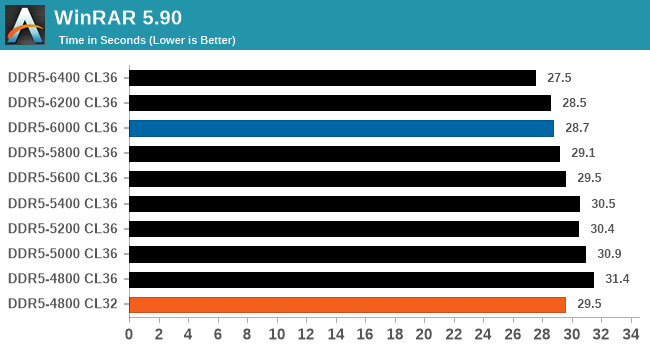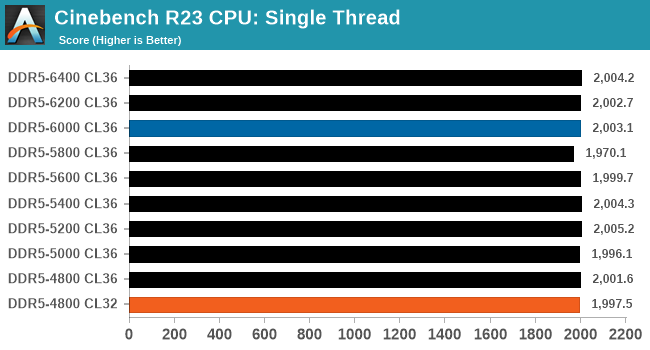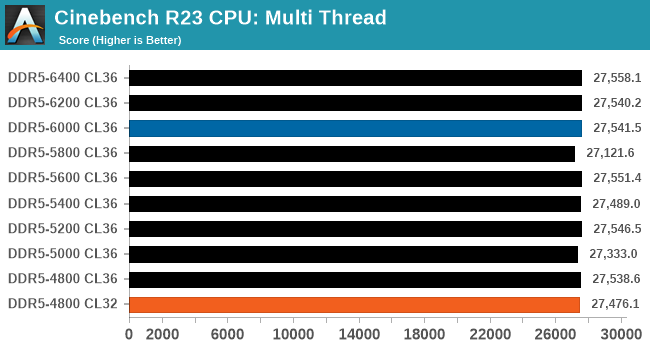Intel Alder Lake DDR5 Memory Scaling Analysis With G.Skill Trident Z5
by Gavin Bonshor on December 23, 2021 9:00 AM ESTCPU Performance, Short Form
To show the performance and scaling of DDR5 memory, we've opted for a more selective and short-form selection of benchmarks from our test suite.
Compression – WinRAR 5.90: link
Our WinRAR test from 2013 is updated to the latest version of WinRAR at the start of 2014. We compress a set of 2867 files across 320 folders totaling 1.52 GB in size – 95% of these files are small typical website files, and the rest (90% of the size) are small 30-second 720p videos.

Blue is XMP; Orange is JEDEC at Low CL
In our WinRAR 5.90 benchmark, this is where we saw the most effective and conclusive levels of performance, From DDR5-4800 CL36 to DDR5-6400 CL36, we saw an impressive 14.1 % increase in throughput. Even at the DDR5-6000 CL36 XMP, there was a 9.4% jump in performance in terms of scale from the baseline.
The DDR5-4800 CL32 also provided a good uplift in performance here. It should also be noted that WinRAR 5.90 performance can be very memory dependant, and it shows in our results.
Rendering - Blender 2.79b: 3D Creation Suite
A high-profile rendering tool, Blender is open-source allowing for massive amounts of configurability, and is used by a number of high-profile animation studios worldwide. The organization recently released a Blender benchmark package, a couple of weeks after we had narrowed our Blender test for our new suite, however their test can take over an hour. For our results, we run one of the sub-tests in that suite through the command line - a standard ‘bmw27’ scene in CPU only mode, and measure the time to complete the render.

Blue is XMP; Orange is JEDEC at Low CL
In terms of scaling performance in our Blender benchmark, we saw very little variation in performance from top to bottom. Although the Trident Z5 at DDR5-6400 CL36 did perform best, it was a modest 0.6% jump in performance from our lowest result to the best.
Rendering - Cinebench R23: link
Maxon's real-world and cross-platform Cinebench test suite has been a staple in benchmarking and rendering performance for many years. Its latest installment is the R23 version, which is based on its latest 23 code which uses updated compilers. It acts as a real-world system benchmark that incorporates common tasks and rendering workloads as opposed to less diverse benchmarks which only take measurements based on certain CPU functions. Cinebench R23 can also measure both single-threaded and multi-threaded performance.


Blue is XMP; Orange is JEDEC at Low CL
Looking at performance in Cinebench R23, the results were a little sporadic, in both the single-threaded and multi-threaded testing. All of the results in the single-threaded test were within a margin of 1.8%, with the multi-threaded results within a 1.6% level of variation from top to bottom.
3DPMv2.1 – 3D Movement Algorithm Test: link
3DPM is a self-penned benchmark, taking basic 3D movement algorithms used in Brownian Motion simulations and testing them for speed. High floating point performance, MHz, and IPC win in the single thread version, whereas the multithread version has to handle the threads and loves more cores. For a brief explanation of the platform agnostic coding behind this benchmark, see my forum post here.

Blue is XMP; Orange is JEDEC at Low CL
Similar to what we saw in both Cinebench R23 and in our Blender benchmarks, performance in our 3DPM v2.1 testing shows little to no improvement with faster memory across the range of results. The level of variation between the best result and the worst result was around 0.3%.










82 Comments
View All Comments
bananaforscale - Thursday, December 30, 2021 - link
Command rate of 14? Shirley you mean latency of 14.Oxford Guy - Saturday, January 1, 2022 - link
Yes. Posting with the flu leads to mistakes.Kvaern1 - Sunday, January 9, 2022 - link
I wouldn't call DDR4 3200/3600 expensive highend RAM. 3200 wasn't even expensive when I put it in my old Skylake in early 2016. DDR5 OTOH currently cost about twice as much as DDR4 for basically no gains outside of massively parallel computing realms.Oxford Guy - Wednesday, January 12, 2022 - link
It depends upon whether it’s top-grade B die or not. 3600–14 can be quite pricy.throAU - Thursday, December 30, 2021 - link
uh.... why benchmarking game performance at 4k with a GTX1080 from ... 2016?surely to benchmark CPU vs. memory performance with DDR5 you'd want a relevant GPU to pair with it? one that isn't being strangled at 4k, etc.
throAU - Thursday, December 30, 2021 - link
Saw an earlier comment from Ian - No GPUs available.Well then, I guess don't run GPU limited benchmarks as part of the memory scaling analysis. If you can't run the numbers legitimately, then don't run them. Have to say this is just not up to the usual anandtech high standard we've come to expect over the past 2 decades.
Oxford Guy - Sunday, January 2, 2022 - link
AMD and Nvidia are selling plenty of video cards for high prices that have less performance than a 1080. Cards with less performance than a 1080 and cards with equivalent performance continue to be brought to market.People have been conditioned to assume the only valid tests involve the most expensive cutting-edge consumer hardware because that hardware is typically provided by companies to try to get sales. I remember when this place had chart data points featuring triple SLI GTX setups with the top Nvidia cards of time. Who could afford that and who could tolerate the noise and heat? Other sites have routinely done GPU tests with Intel CPUs that were really expensive. They say it's to eliminate bottlenecks but when the only data involves luxury hardware it can be less informative to the majority of buyers who aren't going to spend that kind of money. The same goes for using a video card like a Titan instead of one at a reasonable price point. Not only were cards in that line overpriced, they had a short market lifespan as I recall. Buying one was more about bragging rights than value for one's money.
If the video card being used were a GTX 580 or something else that's totally irrelevant to contemporary gaming then you could call the data illegitimate legitimately. What it actually is is legitimate data that's not as complete as you'd like. I would particularly like to see DDR-4 performance in any article's charts about DDR-5's performance. Not having that doesn't make the data invalid, just less convenient.
Many would be happy to have 1080-level performance given the current situation. Extremetech was actually recommending that people look at the ancient 290X due to the GPU pricing situation.
Vega cards, which weren't so impressive (especially in performance-per-watt but also in performance-per-decibel) when they were new are now in their second round of mining-induced gouging. The pricing for those used is preposterous and yet that's the situation we're in.
Unless you have quite a bit of disposable income for gaming you're unlikely to have a 3080/3090 now or in the near future. It may be that testing with a 3090 would be more irrelevant than with a 1080 simply due to the smallness of the percentage of those who will own a card with that performance in the near future and present.
TheinsanegamerN - Monday, January 3, 2022 - link
"People have been conditioned to assume the only valid tests involve the most expensive cutting-edge consumer hardware"People are smart enough to use their brains, and realize that to test scaling of a component you must remove every possible bottleneck not related to said component. running a GPU limited test on a memory scaling benchmark is utterly pointless.
"AMD and Nvidia are selling plenty of video cards for high prices that have less performance than a 1080"
Intel sells lots of CPUs that are slower then a 12900k. Shoudl they have used a pentium G6400 for these tests? How about 2133 mhz DDR4?
See, sales nubers are not relevant to scaling tests. We are concerned with how well a certian part scales, not how well it sells. Why is this so hard for people to understand?
Oxford Guy - Tuesday, January 4, 2022 - link
'See, sales nubers are not relevant to scaling tests.'If the tests don't match the product usage the tests aren't relevant.
Tom Sunday - Tuesday, January 4, 2022 - link
All said and done I am still running with DDR3 memory on my used and hobbled together DELL XPS 730X from 2008. If I had the money now and having a meaningful job, I would most certainly buy DDR5 and an Alder Lake set-up to be happy